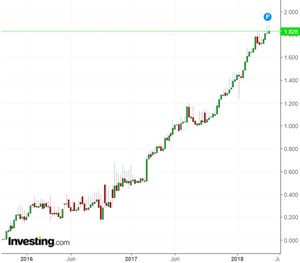What I'm going to tell you is probably going to go a fair way toward upending your sense of reality and everything you know to be true, at least as far as the markets go.
Think for a second how much mental energy, how many newspaper column inches, how many magazine articles, how many minutes of airtime are totally devoted to speculating on what the U.S. Federal Reserve's going to do to interest rates.
There are journalists and cable TV pundits who spend entire careers covering the Fed. Every time the Fed's Open Markets Committee meets, it's like time stops, and every breath hinges on, "Will they raise rates? How much? How high?"
By statute, the FOMC circus must happen eight times a year, every five to eight weeks. And it's even more frequent (and more protracted) if you count the media monkey circus surrounding it, the arcane rituals of painstakingly parsing out what the Fed is "telegraphing" or how the markets will "react."
And it's all for nothing. That's right. Nothing. It's a sham...
...because the Fed does not control interest rates. And it hasn't for years now.
So who does control rates? Well, here's where it gets terrifying...
[mmpazkzone name="in-story" network="9794" site="307044" id="137008" type="4"]
These Days, the Fed Is Just the Market's Rubber Stamp
Now, back in the good old days, before quantitative easing (QE), the Fed did control rates, because it kept reserves in the banking system to a bare minimum. That way it could add or withdraw a little cash from the system on a daily basis to keep the federal funds rate near its target.
The federal funds rate is the interest rate that banks charge each other to borrow reserves overnight. Banks that were short of reserves borrowed; banks that had a little extra lent the funds.
You Must Act Now: America is headed for an economic disaster bigger than anything since the Great Depression. If you lost out when the markets crashed in 2008, then you are going to want to see this special presentation...
If the federal funds rate was trading above target, the Fed would add just enough cash to the market to cause the rate to fall back into the target band. If federal funds were trading below target, the Fed would likewise pull a little money out of the system. Keeping reserves generally tight allowed the Fed to manipulate those rates toward its target.
And it never, ever talked about or "telegraphed" any of it. There was no media circus like we have today.
It was the task of individual traders and investors to parse the Fed's otherwise cryptic moves.
But in 2018, with still a couple trillion dollars' worth of excess reserves in the system, the Fed couldn't do that if it wanted to.
The vast majority of banks have plenty of reserves and don't need to borrow federal funds to meet their minimum reserve requirements.
There you have it: The Fed really doesn't control rates.
The real "mechanism" that sets interest rates? The supply of and demand for short-term paper drives rates. The Fed just rubber stamps what the market has already done, ratifying - not controlling.
 It's simple supply-and-demand market physics; the market tightens all on its own.
It's simple supply-and-demand market physics; the market tightens all on its own.
That's just what it's doing now.
It skipped even that flimsy pretense this month, making it absolutely clear that rates are rising on their own.
The undeniable proof is in the skyrocketing rate on the 13-week T-bills you can see at left.
It is rising relentlessly, whether the Fed raises the federal funds target or not.
And that's indicative of a bigger, wider, and altogether much nastier problem...
Why This Year (and What Comes After) Will Be Worse
Every year, the Treasury, flush with its annual mid-April tax revenue windfall, uses that cash to pay off some debt in the short run. This year, from April 5 through April 26, paydowns amounted to $133 billion.
When the Treasury pays down debt, it puts money back in the accounts of the dealers and institutions which held the maturing paper.
No Place for Fear, Panic, or Mistakes: You may only have a few months to prepare. A market signal that showed up before the Great Depression... before the dot-com crash... and before the 2008 financial crisis has just appeared again. Click here.
That extra cash boosts the stock and bond markets virtually every year in April and May. There's never any mystery why the market usually rallies during that time. We're always on the lookout for it, as we were this year.
But borrowing - Treasury supply - usually resumes in May and increases after that, particularly in the third quarter.
That was no problem when the Fed was printing money and pumping into primary dealer accounts via QE every month.
But today, the Fed is doing just the opposite, pulling money out of the system. That makes the seasonal increase in Treasury supply headed our way a big problem. It'll get bigger, too. The Trump tax cuts and concurrent massive increase in government borrowing means an average of $100 billion a month in new supply is expected.
There's simply no way the system can absorb that supply and sustain the simultaneous rallies in stocks and bonds that folks have become accustomed to in the aftermath of trillions of dollars of quantitative easing.
There's not enough liquidity left. So what happens is what we're seeing: stock-bond asset rotation, day to day, week to week. Sometimes both assets do rise concurrently for a day or so, but that invariably leads to both selling off together for a few days, usually to lower lows.
As I've said, something's got to give, and when that "something" - the market - gives, it will be unbelievably ugly, and we'll be front-row spectators to a relentless, brutal decline in prices. This won't be a garden-variety, six-months-and-we're-done bear market, but a protracted, 18- to 30-month plunge in prices.
That's why I'm so adamant my readers have at least a 60% or 70% cash position by now. If you don't, start building one.
You can get every single one of Lee's recommendations for protecting yourself from what's coming this summer. Just click here to start getting his free Sure Money research - it's a must for every investor. There's never a charge for Money Morning Members.
"Trouble Is Brewing": According to Bloomberg's latest report, America could be heading for an economic disaster that would rival the Great Recession. Billionaire Ray Dalio's hedge fund, Bridgewater Associates, has made a $22 billion bet against the market. And Citibank calls our present situation "eerily reminiscent of the mortgage crisis." To see why we believe some of the richest players in the world are preparing for a market collapse, click here.
Follow Money Morning on Facebook, Twitter, and LinkedIn.
About the Author
Financial Analyst, 50-year charting expert, finance + real estate pro, and market analyst; published and edited the Wall Street Examiner since 2000.



